Electron Machine Corporation is known for high-quality industrial-grade process refractometers. Here's a general explanation of the principles, technologies, and construction behind their refractometers.
Principle of Refractometry:
A refractometer operates on the principle of refraction. When light passes from one medium to another, it changes direction, called refraction. A refractometer measures the degree to which the light changes direction, i.e., the angle of refraction.
A process refractometer uses this principle to measure a process fluid's refractive index (RI). The refractive index measures how much the speed of light reduces within the fluid. It's a characteristic property of each substance and is influenced by temperature and concentration. For solutions, the refractive index can be used to determine the concentration of solutes in the solution, and this is how process refractometers find application in industries.
Technology Behind Electron Machine Corp. Refractometers:
Here's an overview of how these refractometers may function:
- Light Source: A light source emits light into the prism assembly. This light source is usually a long-life LED.
- Prism Assembly: This is where the process fluid comes in contact with the refractometer. The prism assembly usually contains a high-refractive-index glass prism that comes into contact with the process fluid. The light from the source enters the prism and is refracted (or bent) when it exits the prism into the process fluid.
- Detector: After the process fluid refracts the light, it hits a linear photodiode array, the detector. Depending on the refractive index of the process fluid, the angle of the light will change, causing the light to hit the detector at different positions.
- Signal Processing: The refractometer's electronics convert this positional information into a digital signal converted to a refractive index measurement. The device uses the known refractive index of the prism and the angle of refraction to calculate the refractive index of the process fluid.
- Temperature Compensation: Since the refractive index is temperature-dependent, high-quality refractometers will also include a temperature sensor to measure the process fluid's temperature. The device will then apply temperature compensation to correct the refractive index measurement.
- Output: The refractive index or the converted measurement related to the process (like Brix in the food and beverage industry, concentration in the chemical industry, etc.) can be communicated to a central system using standard industrial communication protocols.
Rugged Design and Construction of Electron Machine Refractometers
The refractometers manufactured by Electron Machine Corporation are rugged. They are designed for industrial use in harsh conditions with high temperatures, significant vibrations, and heavily contaminated settings. The refractometer withstands extreme conditions that damage conventional equipment, including considerable temperature fluctuations, high vibration levels, humidity, dust, and potential physical shocks or impacts. They have robust electronics and casings and are built to resist wear and tear, thereby ensuring reliable operation in challenging environments.
https://electronmachine.com
+1 352-669-3101
